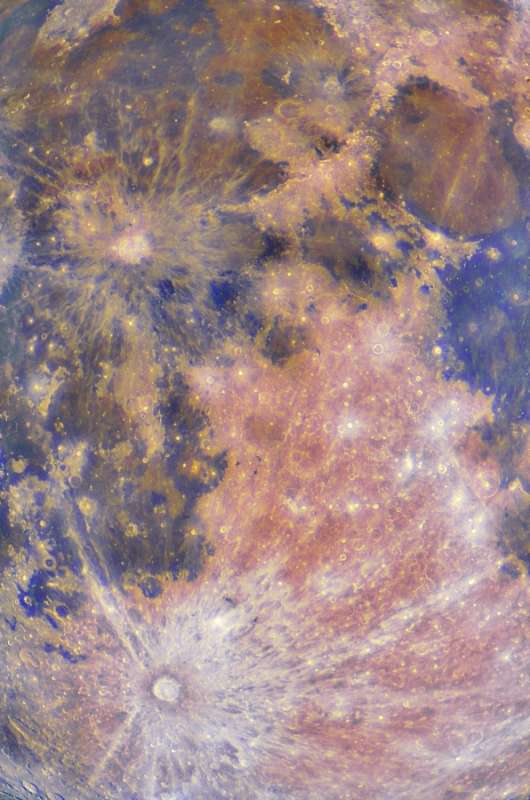Credit & Copyright: László Francsics
Explanation:
The Moon
is normally seen in subtle shades of grey or yellow.
But small, measurable color differences
have been greatly exaggerated
to make this telescopic, multicolored,
moonscape captured during the Moon's full phase.
The different colors are recognized to
correspond to real differences in
the chemical makeup of the lunar surface.
Blue hues reveal
titanium rich
areas while orange and purple colors
show regions relatively poor in titanium and iron.
The familiar
Sea of Tranquility, or Mare Tranquillitatis,
is the blue area in the upper right corner of the frame.
White lines radiate across the orange-hued southern lunar highlands
from 85 kilometer wide ray crater Tycho
at bottom left.
Above it, darker rays from crater Copernicus
extend into the Sea of Rains
(Mare Imbrium)
at the upper left.
Calibrated by
rock samples
from the Apollo missions, similar multicolor
images from spacecraft
have been used to explore
the
Moon's global surface composition.
1999 2000 2001 2002 2003 2004 2005 2006 2007 2008 2009 2010 2011 2012 2013 2014 2015 2016 2017 2018 2019 2020 2021 2022 2023 2024 2025 |
Yanvar' Fevral' Mart Aprel' Mai Iyun' Iyul' Avgust Sentyabr' Oktyabr' Noyabr' Dekabr' |
NASA Web Site Statements, Warnings, and Disclaimers
NASA Official: Jay Norris. Specific rights apply.
A service of: LHEA at NASA / GSFC
& Michigan Tech. U.
|
Publikacii s klyuchevymi slovami:
Copernicus - mare - crater - iron - Luna - lunnaya poverhnost' - krater - himicheskii sostav
Publikacii so slovami: Copernicus - mare - crater - iron - Luna - lunnaya poverhnost' - krater - himicheskii sostav | |
Sm. takzhe:
Vse publikacii na tu zhe temu >> | |
